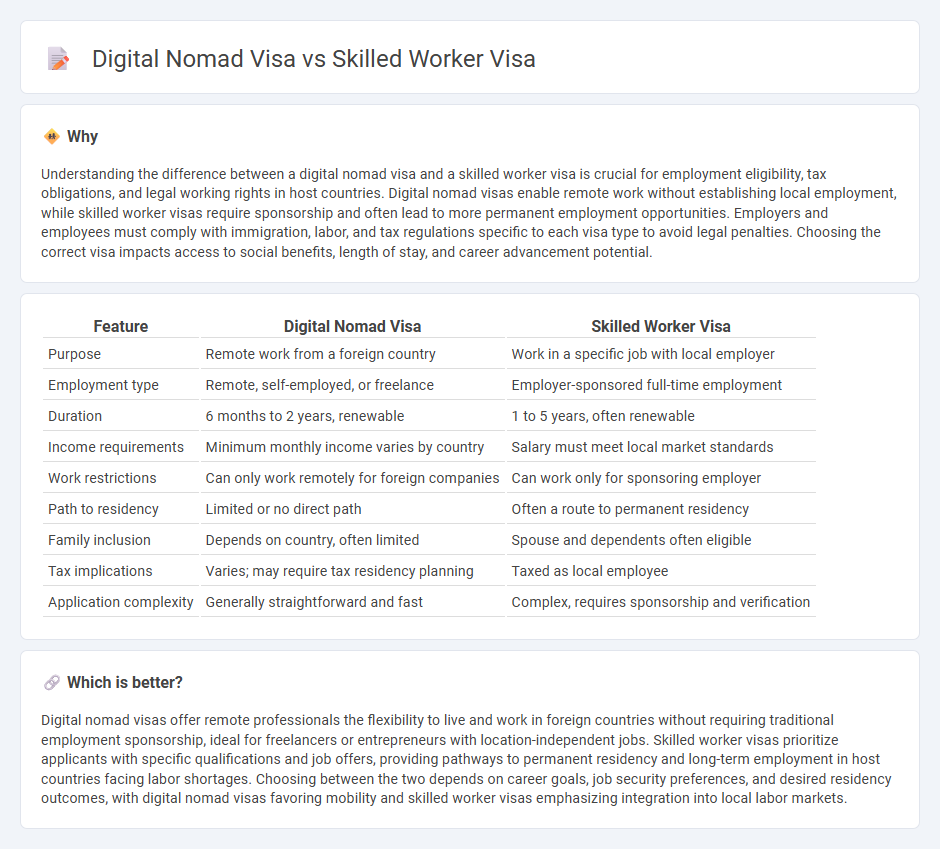
Digital nomad visas cater to remote professionals seeking flexibility and international experience without local employment restrictions, while skilled worker visas target individuals with specialized expertise aiming for long-term residency and career growth within a host country. Employment opportunities under skilled worker visas often require sponsorship and adherence to specific labor market needs, contrasting with the autonomous work model allowed by digital nomad visas. Explore the distinctions and benefits of these visa types to determine the best fit for your professional journey.
Why it is important
Understanding the difference between a digital nomad visa and a skilled worker visa is crucial for employment eligibility, tax obligations, and legal working rights in host countries. Digital nomad visas enable remote work without establishing local employment, while skilled worker visas require sponsorship and often lead to more permanent employment opportunities. Employers and employees must comply with immigration, labor, and tax regulations specific to each visa type to avoid legal penalties. Choosing the correct visa impacts access to social benefits, length of stay, and career advancement potential.
Comparison Table
| Feature | Digital Nomad Visa | Skilled Worker Visa |
|---|---|---|
| Purpose | Remote work from a foreign country | Work in a specific job with local employer |
| Employment type | Remote, self-employed, or freelance | Employer-sponsored full-time employment |
| Duration | 6 months to 2 years, renewable | 1 to 5 years, often renewable |
| Income requirements | Minimum monthly income varies by country | Salary must meet local market standards |
| Work restrictions | Can only work remotely for foreign companies | Can work only for sponsoring employer |
| Path to residency | Limited or no direct path | Often a route to permanent residency |
| Family inclusion | Depends on country, often limited | Spouse and dependents often eligible |
| Tax implications | Varies; may require tax residency planning | Taxed as local employee |
| Application complexity | Generally straightforward and fast | Complex, requires sponsorship and verification |
Which is better?
Digital nomad visas offer remote professionals the flexibility to live and work in foreign countries without requiring traditional employment sponsorship, ideal for freelancers or entrepreneurs with location-independent jobs. Skilled worker visas prioritize applicants with specific qualifications and job offers, providing pathways to permanent residency and long-term employment in host countries facing labor shortages. Choosing between the two depends on career goals, job security preferences, and desired residency outcomes, with digital nomad visas favoring mobility and skilled worker visas emphasizing integration into local labor markets.
Connection
Digital nomad visas and skilled worker visas both facilitate remote and international employment by allowing professionals to legally work in foreign countries. These visas target distinct employment models: digital nomad visas cater to remote workers who provide services online without being tied to a local employer, while skilled worker visas prioritize individuals employed directly by companies within the host country. Together, they reflect evolving global workforce trends by accommodating diverse modes of employment that support cross-border mobility and economic contribution.
Key Terms
Qualification requirements
Skilled worker visas typically require formal qualifications such as degrees, professional certifications, and relevant work experience aligned with specific job shortages or occupational lists, ensuring applicants meet the country's labor market needs. Digital nomad visas often have more flexible or minimal qualification criteria, focusing primarily on proof of remote income, self-employment status, or freelance contracts without stringent educational prerequisites. Explore detailed qualification requirements for each visa type to determine which best fits your professional background and lifestyle goals.
Remote work eligibility
Skilled worker visas typically require applicants to have a job offer from an employer within the host country and are designed for professionals seeking long-term employment, while digital nomad visas are tailored for remote workers who maintain employment outside the host country without the need for a local employer sponsorship. Remote work eligibility for skilled worker visas often involves stringent criteria such as specific job roles and salary thresholds, whereas digital nomad visas focus on proving the ability to sustain oneself financially while working remotely. Explore the detailed requirements and benefits of each visa type to determine the best option for your remote work lifestyle.
Employer sponsorship
Employer sponsorship is a key requirement for a skilled worker visa, as applicants must secure a job offer from an approved employer who acts as a sponsor throughout the visa process. In contrast, a digital nomad visa typically does not require employer sponsorship, allowing remote workers to live and work independently from various locations without a formal employer connection in the host country. Explore the detailed requirements and benefits of each visa type to determine which suits your professional lifestyle best.
Source and External Links
Skilled Worker Visa: Application & Eligibility Guide 2025 - The Skilled Worker visa allows foreign nationals to work in the UK for an approved sponsor in an eligible role for up to five years, with eligibility based on a points system including job offer, salary, and English proficiency.
Skilled Worker visa: Overview - GOV.UK - This visa permits individuals to work in the UK for an approved employer in eligible occupations, requiring a certificate of sponsorship, a minimum salary, and English language ability, with the possibility to extend and apply for indefinite leave to remain after five years.
Skilled Worker visa | Scotland.org - Skilled Worker visa applicants must be over 18, have an eligible job offer and certificate of sponsorship, meet English language standards, have savings or sponsor cover, and apply within three months of receiving their certificate, with options to switch or extend visas within the UK.
 dowidth.com
dowidth.com